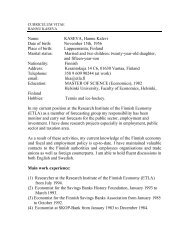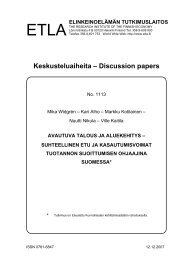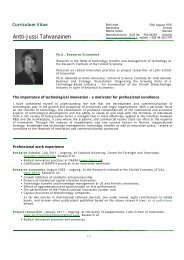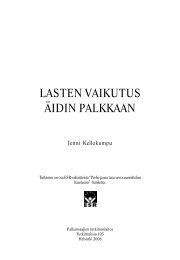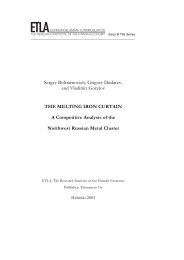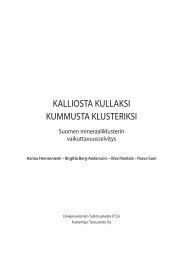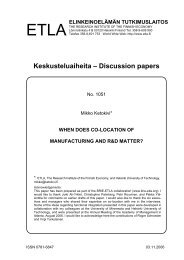Schooling, Family Background, and Adoption: Is it Nature or is ... - Etla
Schooling, Family Background, and Adoption: Is it Nature or is ... - Etla
Schooling, Family Background, and Adoption: Is it Nature or is ... - Etla
You also want an ePaper? Increase the reach of your titles
YUMPU automatically turns print PDFs into web optimized ePapers that Google loves.
All tests demonstrate that permanent family income including permanent<br />
family fact<strong>or</strong>s like parental education, <strong>and</strong> parental IQ are dec<strong>is</strong>ive fact<strong>or</strong>s<br />
in explaining the relation between family income <strong>and</strong> the child’s years spent<br />
in school. Only w<strong>it</strong>h the third method we are able to show that (trans<strong>it</strong><strong>or</strong>y)<br />
family income <strong>it</strong>self matters too. Th<strong>is</strong> observation <strong>is</strong> in line w<strong>it</strong>h<br />
what previous researchers have found. That <strong>is</strong>, direct family income effects<br />
on the child’s schooling attainment run f<strong>or</strong>emost through the permanent<br />
component of family income. And if sh<strong>or</strong>t run variation in family income<br />
(<strong>or</strong> trans<strong>it</strong><strong>or</strong>y family income) exerts a pos<strong>it</strong>ive influence <strong>it</strong>s effect <strong>is</strong> rather<br />
lim<strong>it</strong>ed (see Shea (2000), Cameron <strong>and</strong> Taber (2000), Chevalier <strong>and</strong> Lanot<br />
(1999), Cameron <strong>and</strong> Heckman (1998), Mayer (1997)).<br />
5.2 <strong>Is</strong> <strong>it</strong> nature <strong>or</strong> nurture that matters?<br />
So far we have been rather silent when <strong>it</strong> comes to the effects of abil<strong>it</strong>y.<br />
Fully in line w<strong>it</strong>h other l<strong>it</strong>erature, we find that parental IQ predicts school<br />
perf<strong>or</strong>mance of children. Th<strong>is</strong> implies that the influence of IQ transcends<br />
over generations. An intriguing question deals w<strong>it</strong>h the problem of nature<br />
<strong>and</strong> nurture. <strong>Is</strong> <strong>it</strong> inher<strong>it</strong>ance <strong>or</strong> <strong>is</strong> <strong>it</strong> the environment which <strong>is</strong> the primary<br />
fact<strong>or</strong> in explaining schooling differences of children?<br />
In th<strong>is</strong> Section we will open the d<strong>is</strong>cussion on the her<strong>it</strong>abil<strong>it</strong>y of IQ <strong>and</strong><br />
use inf<strong>or</strong>mation on adopted children. We begin w<strong>it</strong>h estimating equation<br />
(2.6) adding an adoption dummy f<strong>or</strong> adopted children to see how adopted<br />
children perf<strong>or</strong>m in school. In Table 5 we find that adopted children do<br />
w<strong>or</strong>se w<strong>it</strong>h respect to the total years of schooling. We observe th<strong>is</strong> f<strong>or</strong><br />
family income measured in 1975 <strong>and</strong> 1992.<br />
To <strong>is</strong>olate that part of IQ that stems from genetic transm<strong>is</strong>sion we need<br />
to include the IQ covariate f<strong>or</strong> adopted children. Th<strong>is</strong> <strong>is</strong> what we do in the<br />
second column of Table 5 where we estimate equation (2.8). IQ c<strong>or</strong>rections<br />
f<strong>or</strong> adopted children turn out to be negative which c<strong>or</strong>respond w<strong>it</strong>h the idea<br />
that intelligence measured as childhood IQ <strong>is</strong> to a certain extent inher<strong>it</strong>ed.<br />
Note however that these effects are significantly negative in the margin.<br />
Only if we use family income measured in 1975 interacted IQ effects are<br />
significant at a 10 percent level. Th<strong>is</strong> turns out to be a cell size effect.<br />
In the present sample of 6460 children only 114 are adopted. Later on we<br />
will use a much larger sample <strong>and</strong> find all relevant adoption effects to be<br />
significantly different from zero.<br />
Our model also provides estimates on how much can be attributed to<br />
environment <strong>and</strong> how much to genes. The parameter estimates attached to<br />
16




